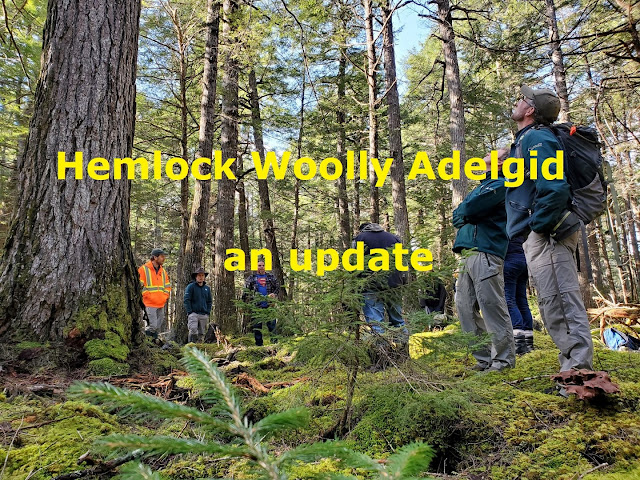It's been five years since hemlock woolly adelgid (HWA) was first identified in south west Nova Scotia.
This post is an update about the bug, efforts being made to control it and specific actions for you.
Where is HWA in Nova Scotia?
The map above shows red dots where HWA has been confirmed in Nova Scotia. The same map from two years ago confirms HWA making a rapid march from west to east across the province. In just two years, Lunenburg and Kings County have infestations and the Canadian Food Inspection Agency has added these counties to their restrictions on the movement of hemlock.
For a tiny insect that lives most of its life in a stationary state, incapable of moving from its feeding station at the base of a hemlock needle, the species sure does get around!
The map only shows where the bug has been confirmed. An area could be infested and not be on the map. There have been numerous examples of HWA going undetected for several years. Early detection is key because it provides cheaper and more effective options for treatment. If you believe you have seen HWA, please send an email -- with picture(s) if possible -- to hwa@nshemlock.ca
And these maps aren't telling us about the state of the trees in the western most part of the province where the first infestation took place -- many trees are dead and/or dying. In many cases they are untreatable. Once infested, our hemlocks deteriorate very quickly, typically living only 3-5 years.
Pesticide treatment is currently the only option for saving infested trees
If a hemlock becomes infested with HWA, the only way to prevent the tree from dying at this time is by applying a pesticide. Ouch, that hurts to say and I wish there was another solution. But that is the situation until biological controls are in place.
- hemlock dominant stands with existing or potential old-growth
- stands with indigenous cultural value
- protected areas and provincial parks
- stands with special habitat (species at risk, watercourses etc.)
- stands with accessibility and human use
- stands healthy enough to benefit from treatment
- distance to known infested areas etc.
The Hemlock Trail at Keji (c) Curtis Watson
Chemical treatments are a short-term solution -- what about the long term?
You can help stop the hemlock woolly adelgid (HWA) from killing our Nova Scotian hemlock trees in three ways:
1- PREVENTION : do not accidentally move HWA from an infested area to an uninfested area.
Fortunately, right now HWA is anchored to the hemlock branches and cannot move so the risk of spread is very small.
This all changes next March/April when the first generation of eggs hatch, with more hatching in the second generation through June-July. The young HWA 'crawlers' start looking for a new home. Many thousands fall to the forest floor and on humans and wildlife as we travel about.
Look for a PSA in the spring with some suggested actions.
2- DETECTION : early detection of HWA means you will have more treatment options.
Now and into the winter is a good time for you to inspect hemlocks to see if there are any signs of the bug as it grows larger and more visible during winter.
Look for a cotton-like sac on the underside of the branch tips where the needle meets the stem.
And if there is a wind or ice storm and hemlock branches are knocked down -- it is a perfect opportunity to inspect infestation levels in the upper canopy among the fallen branch tips.
If you find any signs of HWA, please get pic(s) of the underside of the branchlets and email it to hwa@nshemlock.ca
3- TREATMENT : if you find HWA, you will have to make some decisions.
Two pamphlets will help you. "A Landowner's Introduction to Hemlock Woolly Adelgid" is a good overview and HWA Treatment Decision Key will help you decide which trees are candidates for treatment.
As of the fall of 2022, you will have to contact a certified pesticide operator if you decide to treat your trees. We hope to have an update on treatment options early in the New Year.
* * *
Hemlocks in Nova Scotia are in a fight for their life. We can all do our part to make sure as many as possible survive so our grandchildren can experience the magic of an intact hemlock forest.







